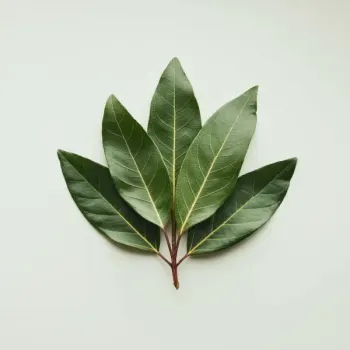Bay leaves and thyme are aromatic herbs used in cooking. Bay leaves, from the laurel tree, provide a subtle depth when simmered, while thyme offers a pungent, earthy taste that can elevate a variety of dishes, suitable for both quick and slow cooking methods.

Bay leaves come from the laurel tree and are used as a fragrant herb in cooking. Their aroma is slightly floral and herbal, and they add a subtle depth to dishes when simmered over time.

Thyme is a Mediterranean herb with a pungent, earthy taste. It's commonly used in cooking for its distinctive and sharp flavor, which can instantly elevate a wide range of recipes.
Bay leaves are larger, more rigid, and are typically used whole and removed before serving. Thyme, on the other hand, consists of small leaves that are often used finely chopped and incorporated into dishes. Bay leaves impart a subtle background note, while thyme offers a more pronounced, earthy flavor. They also differ in their optimal cooking times; bay leaves are suited for long-simmering dishes, and thyme is versatile enough for both quick and slow cooking methods.

Your ultimate Recipe Box, Meal Planner, and Cooking Class all in one
Bay leaves are a staple in hearty stews and broths, releasing their flavor slowly over hours of simmering. A classic beef bourguignon or minestrone soup benefits from the bay's subtle complexity. Thyme shines in soups and stews with its assertive flavor. It pairs well with poultry and vegetable broths, such as chicken noodle soup or a creamy mushroom stew, contributing a savory note that is immediately recognizable.
When roasting meats like pork or lamb, adding whole bay leaves to the marinade or stuffing them with the meat infuses it with a subtle aroma that complements the natural flavors. Thyme is a robust herb that can withstand high heat, making it perfect for grilling and roasting. Sprinkling thyme on roasted vegetables or grilled steaks adds a tasty, earthy essence.
Bay leaves are a key ingredient in many Mediterranean sauces and braises. They are essential in a classic tomato sauce or a slow-cooked lamb shank, where they enhance the other flavors without overwhelming them. Thyme's compatibility with Mediterranean ingredients like olives, tomatoes, and feta cheese makes it ideal for dishes such as ratatouille, Greek salad, or marinated feta cheese.
Both bay leaves and thyme are low in calories and contain various vitamins and minerals. They contribute minimal nutritional content due to the small amounts used in cooking.
| Nutrient | Thyme ( per Teaspoon ) | Bay Leaves ( per Teaspoon ) |
|---|---|---|
| Fat | 0.1g | 0.1g |
| Sodium | 0.3mg | 0.4mg |
| Calcium | 20mg | 6mg |
| Protein | 0.1g | 0.1g |
| Calories | 3 | 5 |
| Carbohydrates | 0.7g | 1.3g |
Bay leaves are typically removed before serving as they can be a choking hazard and are difficult to digest.
Thyme can withstand long cooking times, but its flavor may mellow. For a stronger taste, add fresh thyme towards the end of cooking.
Yes, but dried herbs are more potent, so you'll need to use less. A common ratio is 1 fresh to 1/3 dried.
Certainly! Both herbs can complement each other in dishes like stews, soups, and braises, creating a more complex flavor profile.
Bay leaves should be stored in a cool, dry place. Fresh thyme should be wrapped in a damp paper towel and refrigerated, while dried thyme should be kept in an airtight container away from light.